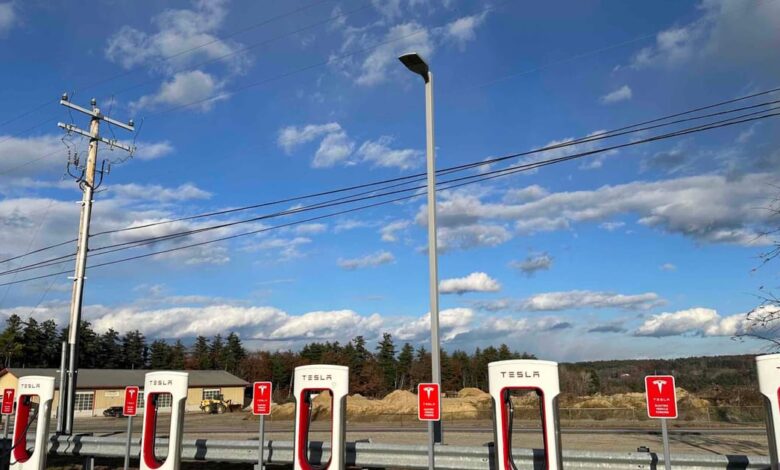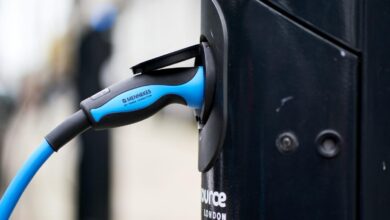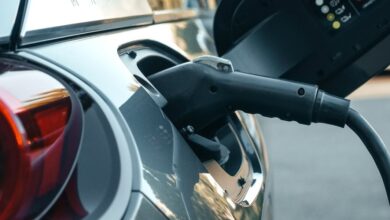Tesla won the EV charging race. So why’s it gutting…

Still, without the Tesla charging team to shepherd the ongoing implementation of that technology across the industry, “further improvements to standards and engagements across the industry will suffer,” Jameson wrote.
Tesla’s layoffs also cast uncertainty over the projects the company has won with state transportation departments as part of the Biden administration’s National Electric Vehicle Infrastructure (NEVI) initiative, a $5 billion formula grant program created as part of the 2021 Bipartisan Infrastructure Bill.
According to data from the EV and charging analytics firm EVAdoption, Tesla won 18 percent of the projects awarded in the earliest round of NEVI awards for five states, worth about $8.5 million, the Wall Street Journal reported in September. By February of this year, Tesla had racked up wins for projects in seven of 15 states that had announced their NEVI awards, according to EVAdoption data, E&E News reported.
To participate in the federal program, Tesla had to make its chargers usable by EVs beyond its own — a requirement seen as the impetus behind Tesla’s push to make NACS an open standard.
But simply certifying the NACS technology standard is just the first step in a long and arduous process of working with multiple EV and charger manufacturers, technology providers, and public and private-sector partners, said Nigro of Atlas Public Policy — work that’s all new to the previously closed-off Tesla. The checkered history of other U.S. public charging networks, which have struggled to maintain high levels of reliability and service quality despite using a common charging technology standard, indicates how hard that can be in the real-world.
“There’s a lot of external communication that goes on between a charging provider like Tesla and utilities, state agencies, or automakers trying to get access to the Supercharger network,” Nigro said. “Losing those contacts and all the expertise is going to be expensive and will introduce delays in the rollout of new charging sites, or the availability of the Supercharger to more automakers.”
There’s an enormous gap between the EV charging that’s been deployed to date and what is needed to meet the Biden administration’s goal for EVs to make up half of all U.S. car sales by the end of the decade. Analysts predict that the U.S. will need between 500,000 and 1.2 million public charging ports by 2030 to achieve that goal. The Department of Energy’s National Renewable Energy Laboratory estimates that the U.S. will need 182,000 fast chargers to support between 30 million and 42 million EVs on the road by 2030.
Today, the country has just over 41,000 fast-chargers — and more than half were built by Tesla.
What is EV charging worth to Tesla?
The value of the Supercharger network to Tesla’s underlying EV business is hard to determine.
From the perspective of its value as a marketing and sales tool, “it’s likely a very sizable profit center for the company,” given its intangible but unquestioned value in convincing EV buyers to opt for a Tesla instead of a competing EV, Nigro said.
“If you just look at it as a seller of energy, that’s less clear,” he said. “Making money selling electrons is hard.”
Tesla doesn’t break out the performance of its Supercharger business unit in its broader financial reporting. But Bloomberg estimated in April that the company generated about $1.74 billion in revenue from its chargers last year.
Given its prospects of serving large swaths of the future U.S. EV charging network, “the Supercharger network is going to be printing money very soon,” said Bill Ferro, CTO of Paren, an EV-charging reliability and data analytics company. “Now that the industry has selected the connector, they appear to be abandoning their network,” he said — a move that “simply defies logic.”
Based on the expansion of its chargers for use by EVs beyond Teslas, the network could achieve $740 million in profit by 2030, Bloomberg projected — a fraction of its $13.6 billion in gross profit last year, but not a financial loss by any means.
But it’s far from clear that Tesla’s broader success in the increasingly competitive EV market relies on it keeping up the pace of the Supercharger deployments that got it to where it is today, said Pavel Molchanov, managing director and equity research analyst at Raymond James & Associates.
“A decade ago, when the entire EV value chain was in its infancy, it was reasonable for Tesla to invest its own capital in deploying chargers,” he said. “But today, there are so many stand-alone companies in EV charging.” These include ChargePoint, Electrify America, and EVgo in North America and BP pulse, Fastned, and Ionity in Europe.
More chargers are also set to be deployed by automakers themselves. Last year, BMW, General Motors, Honda, Hyundai, Kia, Mercedes-Benz, and Stellantis announced plans to invest at least $1 billion to deploy 30,000 charging ports on highways and cities in the U.S. and Canada.
“So there is really no need for Tesla to spend money on what is fundamentally a low-margin commodity business: selling electricity to drivers,” Molchanov said. “If everything at Tesla were going perfectly, these additional expenses would not be a big deal. But given that Musk is aggressively trying to cut costs at the company, the Supercharger division is a logical area to look at.”
This short-term financial logic may be cold comfort to all the companies and public agencies that have wedded their EV charging expansion and reliability improvement plans to Tesla’s core technology. But it may also open up opportunities for charging competitors, said Beia Spiller, director of the transportation program at Resources for the Future, a nonprofit environmental economics research organization.
“I do think there’s a drawback for people expecting Tesla to expand into their areas and to see these chargers deployed through NEVI,” she said. But “the good news is that the standard does exist. Who’s going to come in and use that standard to build these charging stations?”



